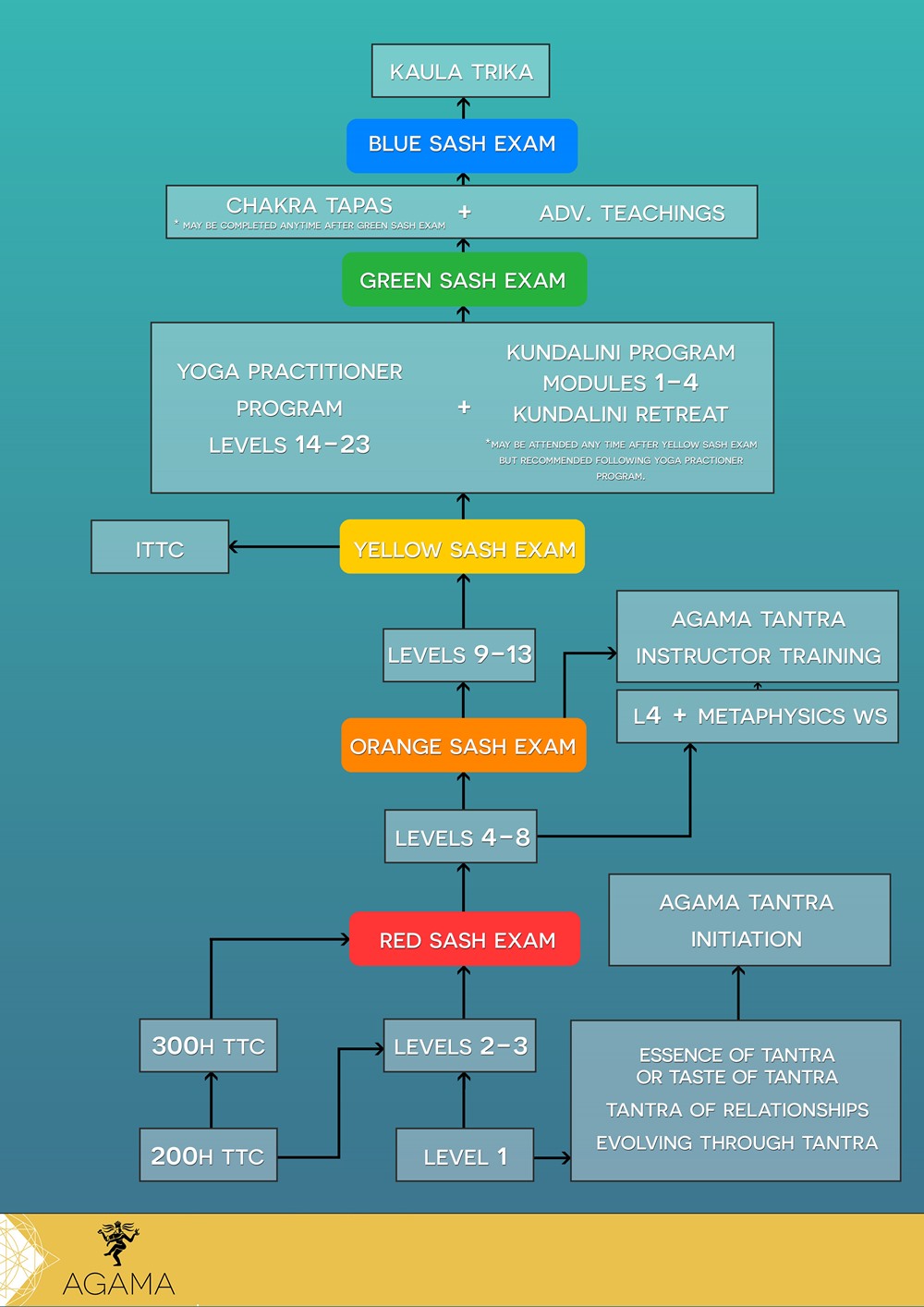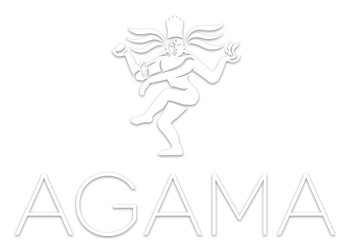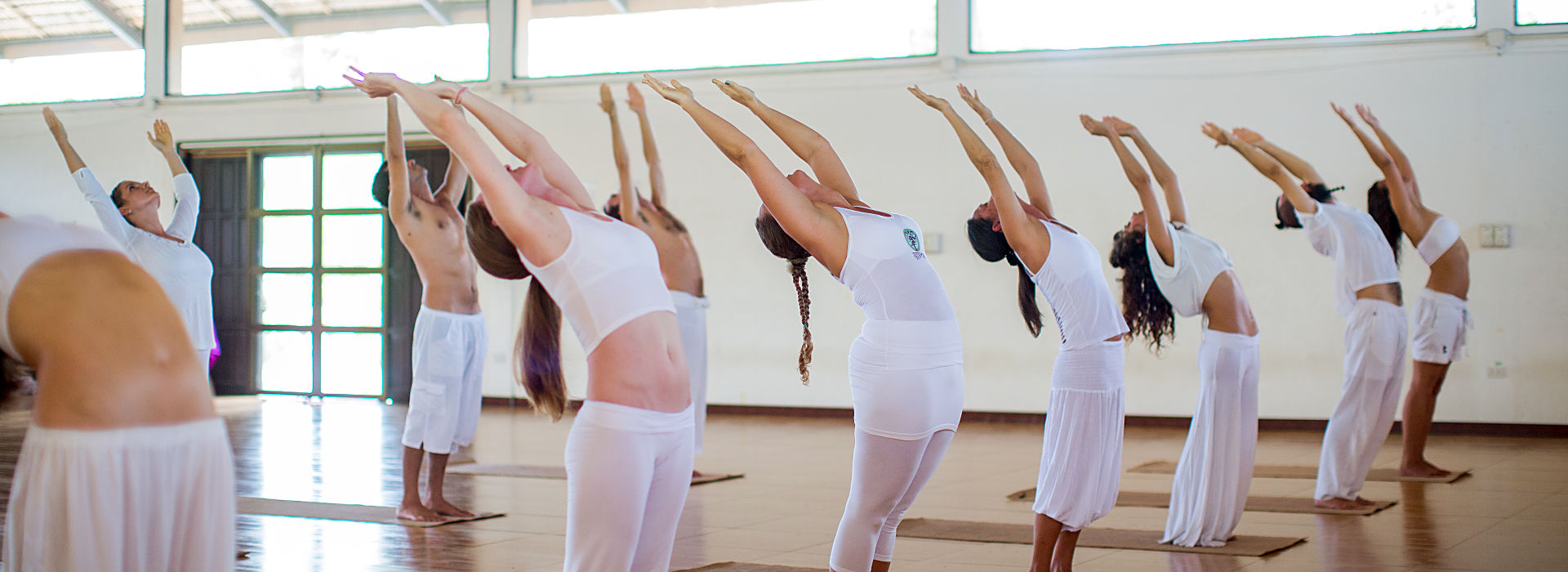The Agama course curriculum is divided into different phases of study, which is illustrated in the graphic below. Start from the bottom up with the Hatha Yoga Program.

The Hatha Yoga program introduces the history and basics of Yoga in its many forms in a very inspiring and empowering way over a period of 13 months. It offers all the details for an efficient practice of the techniques, as well as complete theory. The topics include:
- Full initiation into the techniques of Hatha Yoga (asanas, pranayama, mudras, etc.)
- The study of the yogic system of purification and healing (Shat Karma Kriya)
- Exploration of other traditional branches of Yoga, such as Karma Yoga, Jnana Yoga, and Bhakti Yoga
- The original use of mantra and yantra
- Transmutation and sublimation of the sexual energy, and the principles of erotic Tantra
- Nidra Yoga, conscious dreaming, and astral projection
- The colored subtle streams of energy and their applications, including the study and subtle perception of the aura
- The tantric system of meditation
- A practical study of the classical texts of Yoga (Yoga Sutra, Gheranda Samhita, Shiva Samhita, Hatha Yoga Pradipika) and Eastern philosophy.
During this first phase of the Hatha Yoga program, there are 3 Sash exams: Red Sash at the end of Level 3, Orange Sash after completing Level 8, and the Yellow Sash at the end of Level 13. After passing the Yellow Sash exam the student may continue to the second phase.
The second phase then consists of two parts:
a) The Yoga Practitioner Program, a continuation of the Hatha Yoga program, a 10-month deepening study of Hatha Yoga, which runs as levels 14-23.
b) The Kundalini Yoga program, four one-month-long modules that focus on the awakening of Kundalini Shakti. Topics include:
- In-depth practice of Kundalini Yoga (the arousing of Kundalini Shakti, advanced mudras, bandhas, and kriyas)
- Raja Yoga, mental concentration, paranormal powers in Yoga, the arousing and use of healing magnetism, hypnotism, self-suggestion, and telepathy, psychic self-defense, and the subtle perception of previous lives
- Astrology in connection with Yoga
- Kaula Tantra techniques, and other tantric applications
The program concludes with an intense Kundalini Retreat. The student who wishes to attend the Kundalini program is required to apply beforehand and has to pass an entrance exam in order to be accepted.
Students can participate and complete the Yoga Practitioner Program and the Kundalini Program in any order. It is possible to alternate studies by doing some Kundalini modules one year and some Yoga Practitioner levels another year. Thus one can gradually complete both programs either after each other or by alternating over a perio of minimum 2 - 2.5 years. After completing both the Yoga Practioner and Kundalini program one can take the Green Sash exam which will allow entry into the third phase.
The third phase consists of:
a) The Chakra Tapas, a unique and powerful 16-month discipline for all seven chakras, exploring their levels of consciousness. It emphasizes practice and includes an in-depth study of the chakras and their awakening mainly through Laya Yoga.
b) The Advanced Teachings that focus on the highest Tantra Yoga techniques for reaching states of supramental consciousness and arousing the crown chakra (sahasrara). These teachings include:
- Kashmir Shaivism (Trika) lineages of Pratyabhijna, Spanda, Krama and Kaula; methods for the revelation of the Supreme Self (Atman), and techniques for reaching supramental consciousness (samadhi)
- The nature of the five elements (tattvas) and Svara Yoga
- Initiation in techniques for contacting the various classes of angels and other subtle entities
- Initiation in the Tibetan techniques of Pho-va (transfer of consciousness), Kalachakra, and the Tibetan system of meditation
Many of these initiations have never before been given to Westerners, and therefore require special levels of commitment. This curriculum unfolds within a supportive relationship with teachers who teach from experience and, given dedicated practice, it guides serious students to supreme levels of spiritual evolution.

